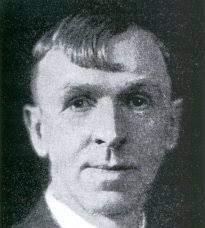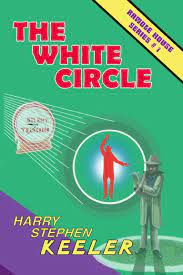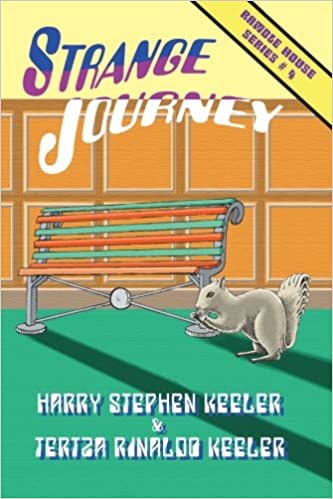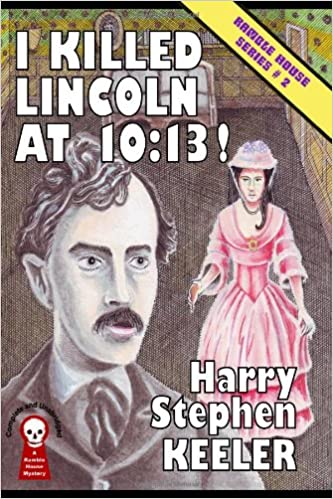 Ramble House is a most unique Washington, D.C. residence where three sets of characters get caught up in outrageous tales that involve insanity, séances and time travel. The creator of this abode was the incomparable Harry Stephen Keeler, the most bizarre mystery writer who ever lived, although as we’ll see, the three books under discussion, THE WHITE CIRCLE, STRANGE JOUREY and I KILLED LINCOLN AT 10:13!, aren’t mysteries.
Ramble House is a most unique Washington, D.C. residence where three sets of characters get caught up in outrageous tales that involve insanity, séances and time travel. The creator of this abode was the incomparable Harry Stephen Keeler, the most bizarre mystery writer who ever lived, although as we’ll see, the three books under discussion, THE WHITE CIRCLE, STRANGE JOUREY and I KILLED LINCOLN AT 10:13!, aren’t mysteries.
In fact, the first two of these books can be classified as science fiction, of which Keeler had something of a history. An entire essay can be (and has been) written about Keeler’s flirtation with SF, with his most famous story “John Jones’s Dollar” (in which a one dollar bank account is increased by compound interest to the point that it becomes the greatest fortune in the universe) falling into that category. Likewise the mind-boggling epic THE BOX FROM JAPAN, a 1932 mystery set in the future year 1942 (in which Mexico is embroiled in a revolution, 3-D television is a reality and guillotines have been installed in place of electric chairs). Part of Keeler’s unique genius, I’d argue, was his ability to switch and/or combine genres and yet always end up with something indisputably Keelerian. This is to say that the insanely labyrinthine, coincidence-packed storylines, bizarre digressions, crazy character names and even crazier quasi-phonetic dialogue are all contained in these three otherwise atypical Keeler novels.
Another important factor in the Ramble House saga is the fact that these books were exclusively published in English by an outfit called, not coincidentally, Ramble House. Toward the end of his life Keeler was shunned by publishers in America and the UK, meaning his later novels, including THE WHITE CIRCLE and I KILLED LINCOLN AT 10:13!, appeared in Spanish-only editions. It took until the early aughts for these books to be published in their intended language, for which we have Ramble House publishing to thank.
THE WHITE CIRCLE was initially published as EL CIRCULO BLANCO in 1954. It served as the introduction to Ramble House, which here takes the form of an insane asylum containing an upper room in which a white circle has been drawn on the ground. If you step into the circle you can travel through time, the reasons for which are too convoluted to go into here, but they take up a large portion of the narrative, and are a major part of what makes the book such a memorable experience. Keeler’s penchant for fastidious detail ensures that many of the scientific holes left gaping by most time travel stories, such as the movement of the earth, which would make traveling to the same position in another time frame impossible, are filled in (albeit not always convincingly).
BLANCO in 1954. It served as the introduction to Ramble House, which here takes the form of an insane asylum containing an upper room in which a white circle has been drawn on the ground. If you step into the circle you can travel through time, the reasons for which are too convoluted to go into here, but they take up a large portion of the narrative, and are a major part of what makes the book such a memorable experience. Keeler’s penchant for fastidious detail ensures that many of the scientific holes left gaping by most time travel stories, such as the movement of the earth, which would make traveling to the same position in another time frame impossible, are filled in (albeit not always convincingly).
Also interesting are Keeler’s entirely convincing depictions of the thoughts and feelings of the protagonist, one Kirk Solfedge, after he travels several years forward in time. He’s been set up by a crooked judge (named Harnishmacher), and time travel is the only solution to his dilemma, courtesy of a future resident whose name is
but who also goes by the shortened moniker Master Enlightener K-5555. Interesting, but the book is marred by a painfully glacial pace and final “twist” that I saw coming far in advance of the last chapter.
 Ramble House returned in STRANGE JOURNEY from 1965, a novel that like many of Keeler’s later books was co-credited to one of his wives, in this case Tertza Rinaldo Keeler (due to the fact that a short story of hers opens the book, even though has next-to-nothing to do with its content). It went unpublished during their lifetimes, and after reading it I can’t say I’m entirely surprised. It’s essentially a drawn-out rewrite of the earlier book, and an extremely lugubrious one.
Ramble House returned in STRANGE JOURNEY from 1965, a novel that like many of Keeler’s later books was co-credited to one of his wives, in this case Tertza Rinaldo Keeler (due to the fact that a short story of hers opens the book, even though has next-to-nothing to do with its content). It went unpublished during their lifetimes, and after reading it I can’t say I’m entirely surprised. It’s essentially a drawn-out rewrite of the earlier book, and an extremely lugubrious one.
It opens with an insanely long-winded conversation between a judge and his subordinate that takes up nearly 100 pages. This convo serves to outline a set-up that has the protagonist Bakerby Kell being railroaded for falsifying adoption records so the judge can prosecute his 1000th case and get some sort of award. Once the chatter ends Kell is warned of the plot against him by an orderly who happened to be listening in on the chatter. Deciding to flee the country, Kell travels to a house he’s inherited, the Ramble House, where a sealed letter awaits, apparently the “most important letter ever written”. Said missive turns out to be an incredibly involved primer on time travel, and how Kell has been chosen by scientists 2000 years in the future to take part in an experiment that will thrust him forward in time to the far-off year 1992, merely by standing inside that fateful white circle. What follows is appealingly nutty, as you might expect, but also exasperating, with pages of scientific minutia no sane person could possibly be expected to understand and a severely protracted narrative whose sense of momentum is summed up by the first word of its main setting.
Finally we have I KILLED LINCOLN AT 10:13! from 1958, which falls in the middle of this trio chronologically speaking but deserves to be considered separately from its fellows. Unlike THE WHITE CIRCLE and STRANGE JOURNEY, I KILLED LINCOLN AT 10:13! is not science fiction themed, being a period piece set over a century prior to its initial publication.
in the middle of this trio chronologically speaking but deserves to be considered separately from its fellows. Unlike THE WHITE CIRCLE and STRANGE JOURNEY, I KILLED LINCOLN AT 10:13! is not science fiction themed, being a period piece set over a century prior to its initial publication.
If anything, I KILLED LINCOLN AT 10:13! can be classified as a historical thriller (complete with copious footnotes highlighting the author’s research) centering on the killing of Abraham Lincoln, and containing a racial angle that would likely render the book unpublishable today. Yes, the expected wacky Keeler dialects are on full display on these pages, and yes, a great deal of those dialects emit from the mouths of characters that happen to be African American. Keeler does at least face down the topic of slavery with admirable forthrightness, although I doubt that will get him off the hook in today’s climate.
Anyway: the main character is Jarrow Gauntlett, an actor who closely resembles fellow thespian John Wilkes Booth. As is made clear early on, “If anyone had told Jarrow Gauntlett…of the amazing and dramatic real-life play in which, this very day of April 14, 1865, he was to take the leading part!–he would have said “Ridiculous!”” As with most Keeler protagonists, Jarrow finds himself caught up in a hellaciously complicated set of circumstances that lead directly to the Ramble House. Upon arriving Jarrow plans to stay in the upper bedroom of the house where that white circle, which in the other Ramble House novels conferred time travel, is located.
Here that circle is the site of a meticulously worked out fake séance (shades of Keeler’s 1957 novel THE MYSTERIOUS IVORY BALL OF WONG SHING LEE, which concerned the debunking of a would-be psychic), followed by the inevitable mistaking of Jarrow for Booth after it’s learned that the latter has shot Lincoln. Jarrow initially protests his innocence but, in true cockeyed Keeler logic, eventually goes along with the ruse, leading to a climax in which he manages to somehow outwit a ravenous mob and find True Love in the bargain.
I KILLED LINCOLN AT 10:13! is notable for the introduction by Ramble House publishing honcho Fender Tucker, which provides a detailed history of the Ramble House as imagined by Keeler. It comes complete with helpful illustrations of the residence (whose dimensions as described by Keeler aren’t always clear) and mentions of three never published Keeler novels, THE PURPLE ROOM, THE SIGN OF THE CROSSED LEAVES and THE S—V— (which may or may not be another name for STRANGE JOURNEY), that also take place in the Ramble House. I’d like to say I hope to see those books published one day, but based on the severely mixed results of the three novels under review here I’m not entirely hopeful about that possibility.

